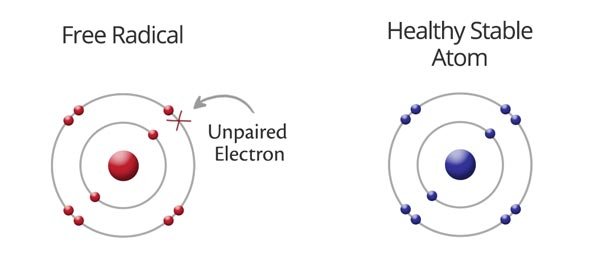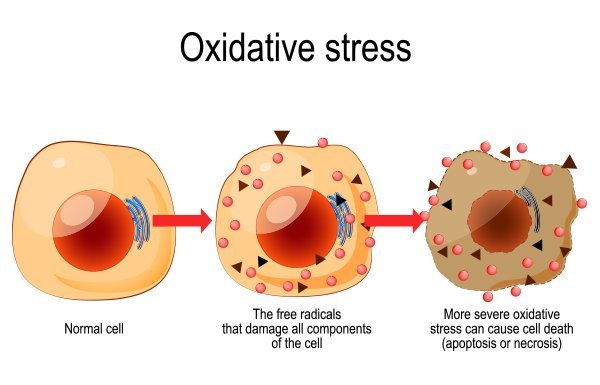INTRODUCTION
Hello Great minds, its always good to make a post in this beautiful platform.
today i will like to talk about free radicals , what they are , their possible benefits , their negative effect and how to scavenge them.
FREE RADICALS
Free radicals are molecules with odd number of electron or unpaired electrons in its outer orbital which can exist independently or freely. The uneven number of free radical makes them not to be stable, extremely reactive and short-lived. Their high reactivity makes them to easily react with other molecules in other to attain stability. This reaction with other molecule will cause it to lose its electron thereby creating another free radical . The new free radicals will also react with another molecule and cause it to lose an electron and that electron becomes another free radical. It continues like that which eventually causes damages to the living cells , DNA and protein. Electrons likes to be in pair, so unpaired ones search the body to look for electron so they can become pairs.
You can also say that free radicals are waste substances the cell produces as our body undergoes metabolism and react to the environment. if the body can not get rid of this free radical efficiently, oxidative stress can set in .This can damage cells and body function and evidentually lead to diseases like cancer, atherosclerosis ( a condition where the arteries become thick and narrow by the build up of cholesterol plaque within its inner walls) , dementia, aging etc.
Interestingly, when free radicals are at moderate or low concentration in the body, they play a very beneficial role, like destroying pathogenic microbes, to synthesize cellular structures etc.
free radicals comprises of the reactive oxygen species(ROS) and the reactive nitrogen specie(RNS).
ROS and RNS have a dual function, they both act as beneficial and harm compounds to the human system.
When ROS and RNS are low or moderate in our body, they are beneficial to us, cause they are involved in our body physiological function like reduction/oxidation regulation, immune function, the ability of the cell to receive, process and transmit signals etc.
But when there high concentration of ROS and RNS in the body, it will result in oxidative stress and nitrosative stress, which are very harmful to the living cell.
OXIDATIVE STRESS
oxidative stress occurs when the ROS production or accumulation in the cells and tissues is higher than the amount of antioxidant that can detoxify these reactive products, which eventually leads to the damage of cells and tissues. This is the major cause of human diseases like rheumatoid arthritis, heart diseases, diabetes mellitus, respiratory diseases , cancer, ageing etc.
PROPERTIES OF SOME FREE RADICALS
Free radicals includes the following;
Superoxide Ion Radical
Hydroxyl radical
Peroxyl radical
Hydrogen peroxide
Singlet oxygen
Ozone
Superoxide Ion Radical : This is usually produced in the powerhouse or energy organelles of the human cell (Mitochondria). They are can exist in two forms which is as a hydroperoxyl radical or still as superoxide ion radical but its hydroperoxyl radical form is the most important form and it can easily penetrate the phospholipid bilayer the very backbone of all cellular and vesicular membranes, than the charged form of superoxide ion radical .
This radical is involved in causing human diseases like cancer, Parkinson’s disease.Hydroxyl radicals : They are very reactive free radicals and can cause severe damage to the cell than any other free radical. it can react with the DNA, lipid, protein and carbohydrate. It is formed when superoxide reacts with hydrogen peroxide in a reaction known as Haber-Weiss reaction.
Singlet oxygen : It is formed when enzymes like lipoxygenases , dioxygenases ,and lactoperoxidase catalyzed some enzymatic reactions. it is a very reactive toxic free radical which can cause damages to the body tissues and DNA.
EFFECT OF FREE RADICALS ON HUMAN BODY
As earlier stated, if free radical and oxidant are in high concentration , they will result in Oxidative Stress. Which has a harmful effect on the DNA and cellular structure. this can lead to various pathelogical conditions like diabetes, cancer, intestinal tract disease, rheumatoid arthritis, burns etc.
- Diabetes Mellitus: this is caused by too much sugar in the blood ( hyperglycemia) which can lead to defective insulin secretion ( Type 1 diabetes) and resistance to insulin action (Type 2 diabetes) . This enhanced blood sugar level causes increase in free radical production in four different ways;
- spontaneous oxidation of glucose which results in production of different free radicals.
- Non enzymatic protein glycation which can lead to the formation of a harmful compound called AGEs ( Advance glycation end products).
- High glycolysis
- And activated polyol pathway.
Neurodegenrative diseases : Here some part of the brain like hippocampus, substantia Nigra, and the striatum are likely to be affected by free radicals, which is due to the presence of increase in lipid content, increase in consumption of oxygen and low amount of antioxidants enzymes.
Cancer: Free radicals cause different types of chemical changes in the DNA which may not be reversible , and this attributes to the cause of cancer. Cancer cells have high concentration of ROS than normal cell, and high levels of oxidative stress because of the activation of mutated gene and loss of tumor suppressors. ROS by changing the growth of signals and gene expression causes continuous increase in the number of cancer cell.
lung cancer : oxidative stress plays a major part in lung cancer. This is the major cause of cancer death in men . it is cause by cigarette smoking , cigarette smoke has complex mixture of so many carcinogens( cancer causing agent) and stable ROS. These damages the tissues leading to cell transformation into malignant forms.
SOME SOURCES OR ACTIVITIES THAT CAN RESULT TO FREE RADICALS
- Smoking cigarette
- Too much of exercise
- Chemotherapy and exposing oneself to chemicals like pesticide and drugs.
- Radiation
- Eating refined and processed food, trans fat, artificial sweetener etc.
- Activities that goes on within the mitochondria
- pollution
SOME WAYS WE CAN MINIMIZE FREE RADICAL INTAKE
Reduce alcohol intake
Avoid food that are rich in refined sugar and carbohydrate
Reduce intake of red meat
cooking oils should not be reused
ANTIOXIDANTS
For a molecule to be stable , it must have the appropriate number of electrons, or it will become a free radical. On the hand, free radicals are harmful molecules that attack the good molecules that supports important body function.
Antioxidants prevent or slow down harms caused by free radicals to the cells. Inotherwords it neutralizes free radicals in our body, hence improving our entire well being.
They include Vitamin C, Vitamin E, beta carotene, lycopene, lutein, manganese etc.
All antioxidants serve different purposes and they cannot be substituted for another, hence its very necessary that we consume variety of them .
Antioxidants source can be natural (plant base) or artificial (supplement) but the best is the plant base source.
Our body also has its own antioxidant too.
Consuming antioxidants can help slow down the risk caused by free radicals.
TYPES OF ANTIOXIDANT
Phytonutrients : They are found in plants with a lot of health benefits.
Anthocyanins : they promote blood vessel health and are found in purple potatoes , garden egg, berries , carrots and asparagus.
Resveratrol : They support heart and lung health and can also prevent cancer . They are found in grapes, dark chocolate , red wine and peanuts.
SOME DIETS THAT ARE RICH ANTIOXIDANTS
Vitamin C: It is not only an antioxidant , it also resurrect other antioxidants that may have been attacked by free radicals for example Vitamin E. They are fruits and vegetables like oranges, berries and capsicum
Beta carotene: Carrots, peas, spinach , water melon, tomatoes ,potatoes and other fruits and vegetables that have bright colours.
Lycopene: Watermelon, tomatoes , guava , grapefruits
Selenium: They prevent the heart and the body from getting certain cancer . They include; whole grain like wheat , corn, maize and also eggs, nuts, cheese.
Vitamin A: diary food like Milk, and also egg, protein like liver.
Some cooked food may have more antioxidants or less . Tomatoes is rich in antioxidant called lycopene, this antioxidant increases or more available when tomatoes is subjected to high heat. While Peas and cauliflower lose much of their antioxidants when they are cooked. whether cooked or raw, variety of antioxidant rich food should be consumed.
WAYS TO INCREASE ANTIOXIDANT CONSUMPTION
Food with rich , bright colours have high antioxidants than food with colours like brown or beige which low antioxidants. Hence , beet, berries, apples and kale are very rich in antioxidant and should form part of our diet.
daily intake of green tea
Taking fruit or vegetable each time we eat
Taking nuts like brazil nut ,and seeds like sun flower seed
SOME RISK ASSOCIATED WITH ANTIOXIDANTS
consuming so much beta-carotene can lead to lung cancer in people that smoke.
High intake of Vitamin E can result to prostrate cancer
Antioxidant supplements can increase the growth of tumor .
CONCLUSION
Having known the effect of free radical and the importance of antioxidant, it is therefore very necessary that we we employ a lifestyle that we keep us in perpetual health.
Thanks for stopping by
God bless you.


Note: You must enter the tag #fintech among the first 4 tags for your post to be reviewed.
Downvoting a post can decrease pending rewards and make it less visible. Common reasons:
Submit